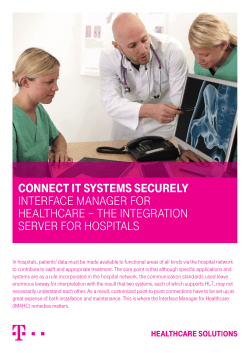
CHIME Response to 21st Century Cures â Interoperability
May 7, 2015 May 7, 2015 The Honorable Fred Upton Chairman, House Energy and Commerce Committee United States House of Representatives Washington, DC 20515 The Honorable Diana DeGette Member, House Energy and Commerce Committee United States House of Representatives Washington, DC 20515 Submitted electronically to: cures@mail.house.gov Re: 21st Century Cures Discussion Draft Legislation – Interoperability Section Dear Chairman Upton and Congresswoman DeGette: The College of Healthcare Information Management Executives (CHIME) appreciates the opportunity to submit comments concerning the Energy & Commerce Committee’s discussion draft of the 21st Century Cures legislation. CHIME has more than 1,400 members, composed of chief information officers (CIOs) and other top information technology executives at hospitals and clinics across the nation. CHIME members are responsible for the selection and implementation of clinical and business information technology (IT) systems that facilitate healthcare transformation. Healthcare CIOs have experience implementing technology that must interoperate with dozens of disparate systems, ranging from diagnostic imaging and biomedical devices, to financial and remote access systems. The frustrations voiced by providers and policymakers regarding the systems deployed in over 80 percent of hospitals and 60 percent of physician offices are real. CHIME shares the vision of an e-enabled healthcare system as necessitated by many of the reforms proposed in 21st Century Cures Initiative. As the nation’s premier organizations of senior health IT executives, we offer a focused set of recommendations on Sec.3001 -- Interoperability. We must first acknowledge that the lack of a consistent patient identification strategy is the most significant challenge inhibiting the safe and secure electronic exchange of health information. As our healthcare system begins to realize the innately transformational capabilities of health IT, moving toward nationwide health information exchange, this essential core functionality – consistency in accurately identifying patients – must be addressed. As data exchange increases among providers, patient data matching errors and mismatches will become exponentially more dangerous and costly. College of Healthcare Information Management Executives 20 F Street NW, Suite 700 · Washington, DC 20001 Phone: (202) 507-6158 · Fax: (734) 665-4922 · staff@chimecentral.org · www.chimecentral.org May 7, 2015 A consistent strategy does not mean a single technology or solution, but an approach that will facilitate the realization of the full benefits and cost savings of nationwide health information exchange, while protecting patient safety and privacy. CHIME calls on Congress to remove the prohibition baring federal regulators from developing standards to improve positive patient identification. With the removal of the outdated prohibition, we believe then that the nation can experience robust information exchange and interoperability. We point to the concept of a longitudinal care record as an illustration of what is possible when the promise of health information technology of becomes a reality. Unfortunately, the development of longitudinal healthcare records - reflecting the patient’s experience across episodes of care, payers, geographic locations and stages of life – remains only an ideal at this time. We believe longitudinal care records should consist of provider, payer and patient-generated data, and be accessible to all members of a patient’s care team, including the patient, in a single location. An information-rich record, supported by widely adopted standards, also should improve a patient’s ability to manage consent privileges and diminish privacy concerns related to the digitization of personal health information (PHI). We believe interoperability cannot be achieved across our fractured healthcare system in a matter of weeks, or even months. Interoperability will not be achieved through a command and control structure, where federal lawmakers or agency rule makers mandate “interoperability.” Interoperability is not something that can be achieved by the electronic health record (EHR) vendors alone, it will require coordination across providers, vendors, exchanges and government entities and will only become more complex as new data sources enter the care continuum. The kind of interoperability that healthcare needs will only happen over time as local settings of care and technology implementations iterate towards conformance to usable, stable and extensible standards. Further, as patient health data become digital, we must ensure stringent privacy and security standards are employed to protect health information as it becomes more fluid. CHIME calls upon the Committee to ensure that security is included in the development of interoperability policy as to recognize the expanded nature of threats to patient data. As the nation’s healthcare systems become more interoperable, additional threats to data integrity will arise without proper safeguards and safe and secure transmissions of sensitive data will continue to be a challenge. CHIME urges the Committee to continue the dialogue relative to expanding Medicare reimbursement for telemedicine services and other meaningful reforms that will expand opportunities to Medicare beneficiaries outside of a traditional care setting using innovative technologies. Medicare reimbursement policies have not kept pace with doctor-patient encounters occurring outside of a traditional care setting, and legal and regulatory barriers continue to impact the ability of providers to initiate or expand their telehealth services. We respectively request the Committee include language to improve existing telemedicine policies as a component of the 21st Century Cures Initiative, to represent the multitude of care encounters that may not look like the traditional doctor-patient interaction. College of Healthcare Information Management Executives 20 F Street NW, Suite 700 · Washington, DC 20001 Phone: (202) 507-6158 · Fax: (734) 665-4922 · staff@chimecentral.org · www.chimecentral.org May 7, 2015 CHIME, once again, appreciates the opportunity to provide comments on this important, bipartisan effort. The attached document provides details of our recommendations for federal government actions to foster widespread healthcare interoperability. Without question, nationwide interoperability and robust health data exchange will be instrumental in executing the innovation espoused by the 21st Century Cures Initiative. If there are questions about CHIME’s recommendations or more information is needed, please contact Leslie Krigstein, Interim Vice President of Public Policy, at lkrigstein@chimecentral.org or (202)507-6158. We look forward to a continuing dialogue with your offices on this and related matters. Sincerely, Russell P. Branzell, CHCIO, LCHIME President and CEO CHIME Charles E. Christian, CHCIO, LCHIME, FCHIME, FHIMSS Chair, CHIME Board of Trustees Vice President & Chief Information Officer St. Francis Hospital College of Healthcare Information Management Executives 20 F Street NW, Suite 700 · Washington, DC 20001 Phone: (202) 507-6158 · Fax: (734) 665-4922 · staff@chimecentral.org · www.chimecentral.org May 7, 2015 Attachment Below, CHIME offers recommendations concerning healthcare interoperability. Interoperability There is a fundamental lack of interoperability across electronic health record systems throughout the country. Patient data does not flow seamlessly in usable forms across care settings and vendor types. CHIME members wish to highlight the enormously difficult socio-technical challenge of making technology systems interoperable; not only does it require harmonizing complex technology systems, but complex systems of policies, processes and people must also align to achieve interoperability. We stress the need for simplicity as an overarching goal of future drafts, but we also caution against any notion that interoperability will come easily or cheaply. Background: While the HITECH Act enabled the rapid, wide-spread adoption of electronic health records (EHRs) across the nation, it has not enabled seamless data sharing across care settings. Consistent with other technology sectors, health IT interoperability requires consistent use of consensus standards and an infrastructure to exchange data. Providers can capture data into an EHR, but they struggle to share it with other providers, especially those using different technology systems. Recommendations: In order to achieve easy access to patient data across care settings, or interoperability, we must fundamentally reevaluate the policies and programs currently at the disposal of the federal government. Consistent with other technology sectors, health IT interoperability requires consistent use of consensus standards and an infrastructure to exchange data. CHIME calls on the federal government to bolster their involvement in health IT programming though: The development and wide-spread adoption of data standards; and The definition of robust testing requirements for certified EHR technology and other components of health IT referenced in federal policies. Standards While we have made impressive progress as a nation on basic EHR adoption, we must refocus our efforts on facilitating interoperability, based on clear, defined and enforceable standards. Industry stakeholders have repeatedly called on the government and private industry to develop a way to test, refine and update health IT standards over time. We commend the Office of the National Coordinator on the release of the proposed 2015 Interoperability Standards Advisory, to help identify key health IT standards. The Standards Advisory signifies a strategic prioritization of federal resources toward the adoption and continued evaluation of common standards to be universally employed by healthcare providers nationwide. College of Healthcare Information Management Executives 20 F Street NW, Suite 700 · Washington, DC 20001 Phone: (202) 507-6158 · Fax: (734) 665-4922 · staff@chimecentral.org · www.chimecentral.org May 7, 2015 CHIME calls on the federal government to drive the use of standards related to the following eight priority areas: 1. Patient identifiers 2. Standards for resource locators (e.g. provider directories) 3. Standard terminologies 4. Detailed clinical models 5. Standard clinical data query language based on the models and terminology 6. Standards for security (standard roles and standards for naming types of protected data) 7. Standard Application Program Interfaces (APIs) 8. Standards for expressing clinical decision support algorithms Industry and government stakeholders need to collaborate on a process that will allow for rapid standards development and refinement, while not impulsively requiring the use of immature standards. The government should support private sector-run test-beds for users and developers of standards as an intermediate step between draft standard for trial use and consensus standard. Further, the government should fund pilot programs to enable providers and software developers to test and enhance implementation guides. The establishment of clear maturity criteria will be necessary in order to assist in the determination of a standard/implementation guide readiness to be endorsed. ONC Certification Program ONC’s Certification Program should be valued as a lynchpin for interoperability and acknowledge the existing voluntary certification program as the only existing means to enforce technology developers’ compliance to federal law. CHIME maintains our request of ONC to reconsider the role and composition of its certification program to address patient safety risks and interoperability. ONC’s certification program was built out of regulatory necessity to accommodate misguided timelines driven by Meaningful Use, not in acknowledgement of how technology is developed, tested, implemented and optimized. This has led to a market dynamic that incentivizes data silos, vendor lock-in and rewards developers who are “first-to-certify” rather than a market characterized by usable, safe and mature health IT products. In so far as certification appears to be one of the government’s best tools to promise adherence to technical standards and specifications, we believe the form and function of certification needs to adapt. Therefore, Congress should enable ONC to enhance its enforcement tools meant to ensure health IT functionalities are effective and they adhere to interoperability standards. Further, we recommend that ONC re-tool its certification program to have a specific focus on betatesting, post-certified performance and live-setting standards adherence, maintaining many of the proposals set forth in the proposed 2015 Edition Health Information Technology Certification Criteria. We believe the results from these more robust tests should be made publicly available, to ensure providers know which products are performing well and adhering to standards in the real-world. By reorienting and leveraging its certification program, ONC could help the private/non-profit sector College of Healthcare Information Management Executives 20 F Street NW, Suite 700 · Washington, DC 20001 Phone: (202) 507-6158 · Fax: (734) 665-4922 · staff@chimecentral.org · www.chimecentral.org May 7, 2015 establish a learning health system to support a 21st century healthcare system, characterized by continuous improvement and consistent accountability. College of Healthcare Information Management Executives 20 F Street NW, Suite 700 · Washington, DC 20001 Phone: (202) 507-6158 · Fax: (734) 665-4922 · staff@chimecentral.org · www.chimecentral.org
© Copyright 2025













